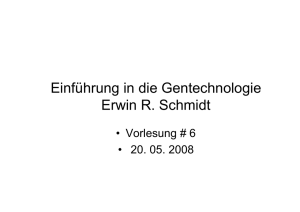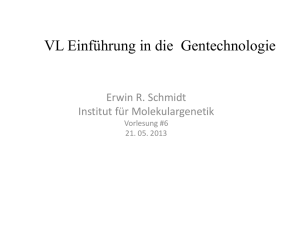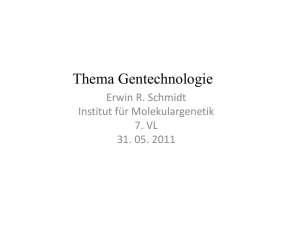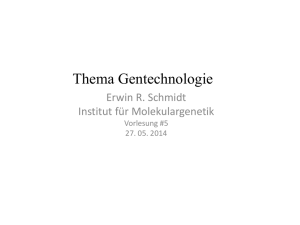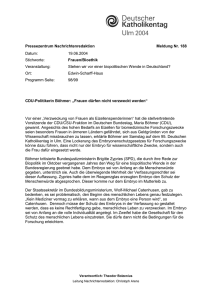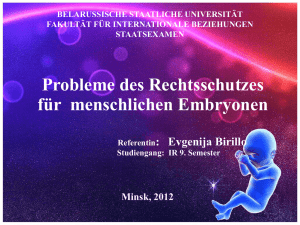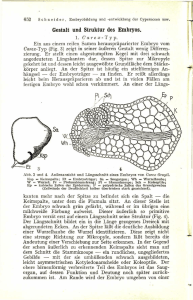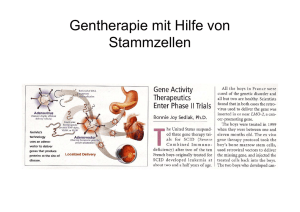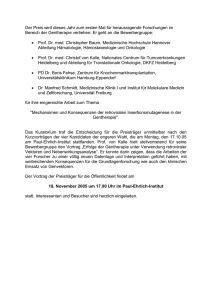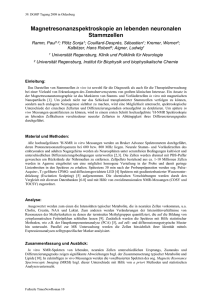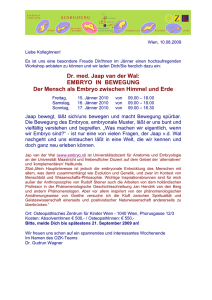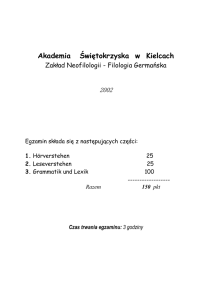Thema Gentechnologie
Werbung
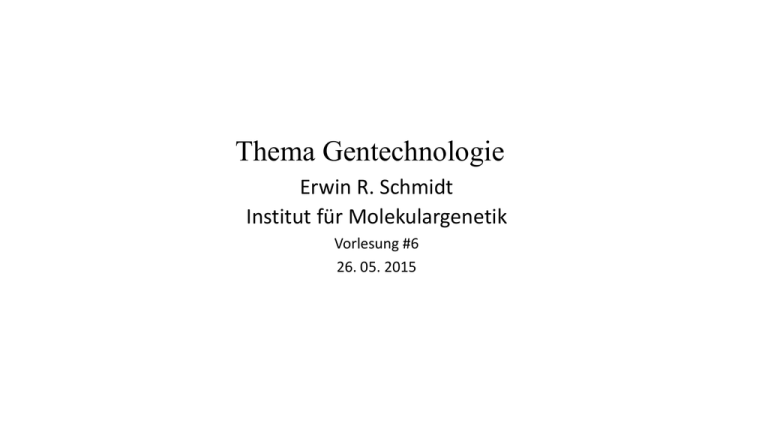
Thema Gentechnologie Erwin R. Schmidt Institut für Molekulargenetik Vorlesung #6 26. 05. 2015 Dolly Dolly with her first newborn, Bonnie • Born in July 1996 at the Roslin Institute in Scotland • First mammal to be cloned from an adult mammal using the nuclear transfer technique • 277 attempts were made before the experiment was successful •Dolly died in February 14, 2003 of progressive lung disease at the age of 6; whereas normal sheep can live up to 12 years of age. Mammal Cloning http://www.howst uffworks.com/cloni ng.htm/printable January 8, 2001 Noah, a baby bull gaur, became the first clone of an endangered animal. Mammal Cloning Timeline 1984 – A live lamb was cloned from sheep embryo cells Megan and Morag 1986 – Early embryo cells were used to clone a cow 1993 – Calves were produced by transfer of nuclei from cultured embryonic cells 1995 – Two sheep, named Megan & Morag, were cloned using embryo cells Dolly 1996 – Birth of Dolly, the first organism to be cloned from a fully differentiated adult cell 1997 – Transgenic sheep named Polly was cloned containing a human gene http://www.cnn.com/2001 /WORLD/europe/08/06/clo ne.critics/index.html Tetra 1998 – 50 mice were cloned in three generations from a single mouse 1998 – 8 calves were cloned from a single adult cow, but only 4 survived to their first birthday 1999 – A female rhesus monkey named Tetra was cloned by splitting early embryo cells. 2000 – Pigs and goats reported cloned from adult cells 2002 – Rabbits and a kitten reported cloned from adult cells http://hs.houstonisd.org/ hspva/academic/Science/ Thinkquest/gail/text/bene fits.html Vergleich der Erfolgsrate bei verschiedenen Tieren Species Number of oocytes used Number of live offspring Notes Mouse 2468 31 (1.3%) - Bovine 440 6 (1.4%) 2 died Sheep 417 14 (3.4%) 11 died within 6 months Pig 977 5 (0.5%) - Goat 285 3 (1.1%) - The table shows success rates of cloning when mature mammal cells were used. Yanagimachi, R. 2002. "Cloning: experience from the mouse and other animals." Molecular and Cellular Endocrinology. 21 March, 187. Development and survival of cloned mouse embryos Majority of the embryos die before and after implantation. This figure shows that the present cloning technique is highly inefficient. Yanagimachi, R. 2002. "Cloning: experience from the mouse and other animals." Molecular and Cellular Endocrinology. 21 March, 187. Table 1. Comparison of cloning success rates in various animals As many investigators did not describe the original numbers of the oocytes used for nuclear transfer, success rates of cloning shown here are based on the numbers of reconstructed oocytes. Molecular and Cellular Endocrinology Volume 187, Issues 1-2, 22 February 2002, Pages 241-248 Biotechnology of Mammalian Cloning Embryo Splitting http://www.faseb.org/opar/cloning /cloning.htm • earliest method of cloning • success limited to embryos split before implantation Parthenogenesis • only possible in females to give female progeny • still investigating – so far mostly failed attempts Nuclear transplantation • main technique in current cloning experiments Kern - Transplantation Enucleation of donor cell Nuclear Transfer • the nucleus of the individual to be cloned is transferred to the cytoplast in one of the 2 ways: 1) electrofusion – whole nucleus donor cell injected beneath the zona pellucida (the outer membrane of the oocyte) and fusion of cells induced by electrical impulses 2) nuclear injection – naked nucleus microinjected into cytoplast Zusammenfassung oocyte cytoplast ENUCLEATION NUCLEAR TRANSFER cytoplast clone cell genetic reprogramming Induktion der EmbryoEntwicklung developing embryo in culture Implantation embryo uterus of surrogate mother Electrofusion http://www.brinkmann.com/pdf/cell_fusion.pdf fusion pulse Cells brought close together Fusion induced by electric pulse Heterokaryon phase: nuclei distinct fusion product Genetische Reprogrammierung Fig. 5 from Nature Reviews Genetics 3: 671 Cloning Humans http://www.cnn.com/2001/WORLD/europe/08/06/clone.doctor/index.html Statistik Gentherapiestudien Eigenschaften eines idealen Vektors: Hohe Konzentration (>108 virale Partikel/ml) Einfache und reproduzierbare Herstellung Fähigkeit zur gezielten Integration in das menschliche Genom oder Fähigkeit zur stabilen episomalen Persistenz Regulierbare Genexpression (regelbarer Promoter) Fähigkeit zum Targeting der Zielzellen Keine Immunantwort gegen den Vektor Gentherapie ist bereits ein „Markt“ Quelle: http://www.awards.frost.com/prod/servlet/press-release.pag?docid=KFEK-5HRFFK Suchbegr Erste Gentherapie zugelassen: FAZ vom 09.01.2013 Gentherapien Die nächste Phase der Biotechbranche Zum ersten Mal ist in Europa eine Gentherapie zugelassen worden. Jetzt steht der Hersteller vor der Aufgabe, die teure Entwicklung auf den Markt zu bringen. 09.01.2013, von Sebastian Balzter, Amsterdam Stoffwechselkrankheit Lipoprotein-Lipase-Mangel (LPLD) Erfolgreiche Gentherapie mit tödlichen Nebenwirkungen • X-linked severe combined immunodeficiency disease (X-SCID), bekannt als ´bubble baby syndrome´ • 11 Patienten fehlte das Gen IL2RG • Das Gen wurde in Stammzellen der Kinder überführt • Zwei (inzwischen 3) Kinder entwickelten Leukämie, bzw. einen lymphatischen Tumor • Das Transgen war bei beiden Kindern in das Tumorgen LMO2 hinein gesprungen Gesetz zur Regelung der Präimplantationsdiagnose 21. 11.2011 (1) Wer Zellen eines Embryos in vitro vor seinem intrauterinen Transfer genetisch untersucht / / wird mit Freiheitsstrafe bis zu einem Jahr oder mit Geldstrafe bestraft (2) Besteht aber auf Grund der genetischen Disposition / / einer schwerwiegenden Erbkrankheit // handelt nicht rechtswidrig Pflanzengentechnologie Ein natürlicher Helfer für die Pflanzengentechnologie ist das Bakterium Agrobakterium tumefaciens Tumorgallen durch A. tumefaciens Pflanzengentechnologie A. tumefaciens injiziert die T-DNA in die Pflanzenzelle, um sie zu mehr Wachstum anzuregen Pflanzengentechnologie DNA-Transfer mit Hilfe von Agrobakterium tumefaciens http://www.sciencemag.org/cgi/reprint/294/5550/2317.pdf How Agrobacterium genetically transforms plants. From the following article: Agricultural biotechnology: Gene exchange by design Stanton B. Gelvin:Nature 433, 583-584(10 February 2005) Typischer Pflanzenvektor auf der Basis des Agrobakterium tumefaciens Ti-Plasmids Quelle: Agrobacterium-mediated transformation of the filamentous fungus Aspergillus awamori Caroline B Michielse, Paul J J Hooykaas, Cees A M J J van den Hondel & Arthur F J Ram Nature Protocols 3, 1671 - 1678 (2008) Published online: 2 October 2008 doi:10.1038/nprot.2008.154 The Agrobacterium strain used for transformation carries two plasmids. A nononcogenic disarmed tumor-inducing plasmid (Ti plasmid) containing the virulence (vir) genes, but lacking the T-DNA region. The T-DNA region is present on a second plasmid, the binary vector. The selection marker in the binary vector used in this study is the kanamycin resistance gene (kanr) (Table 2). DNA sequences to be transformed are cloned between the left and right border sequences of the T-DNA region and transferred to the host. The Ti-plasmid used for A. awamori described in this protocol is (pTiB6), which contains the spectinomycin-resistance gene (spcr) Funktionen der wichtigsten Vir-Gene Locus Gene Funktion Mutantenphänotyp A B 1 11 Histidinsensorkinase avirulent Proteinkomplex für den Transfer der T-DNA aus avirulent Transkriptionsaktivatorprotein avirulent Verstärkung der VirD1/D2-Wirkung attenuiert Topoisomerase Endonuklease/Nukleäres Targetsignal avirulent Chaperon für VirE2-Transport Einzelstrang-Bindeprotein für T-DNA dem Bakterium in die Pflanzenzelle G C D D E E 1 2 4 D1: 2: 2 E1: 2: Interaktion zwischen Bakterium und Pflanzenzelle Quelle (Zhu J et al [2000] J Bacteriol 182: 3885-3895)
